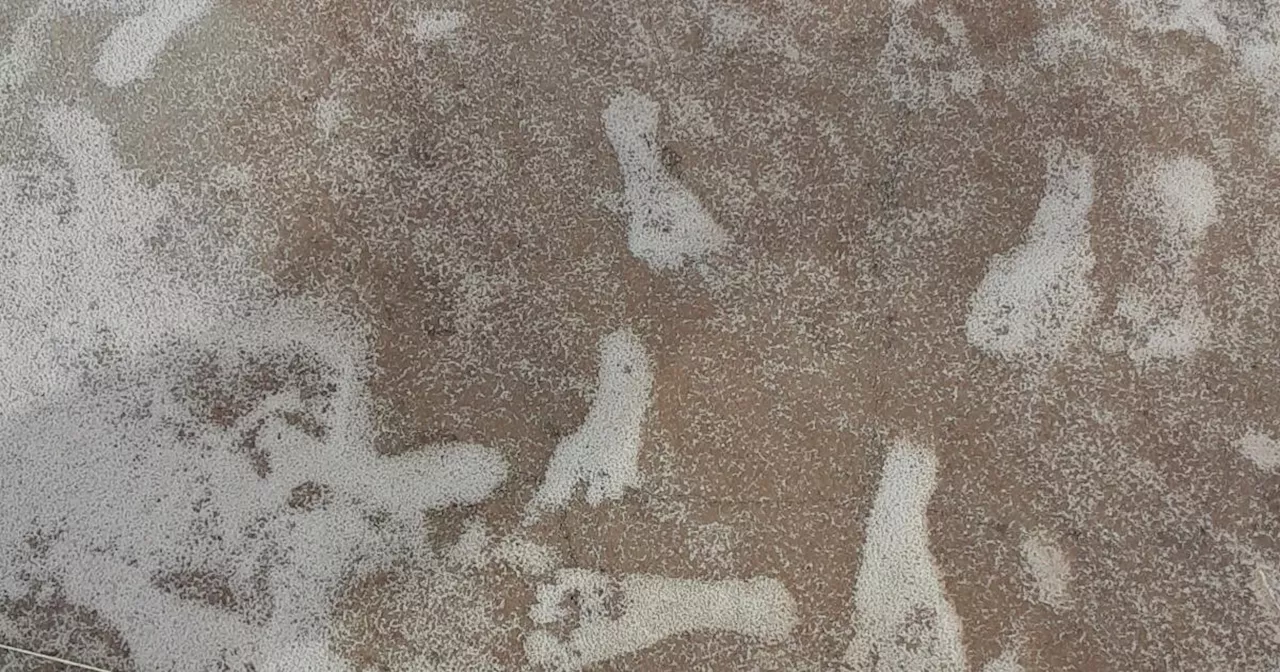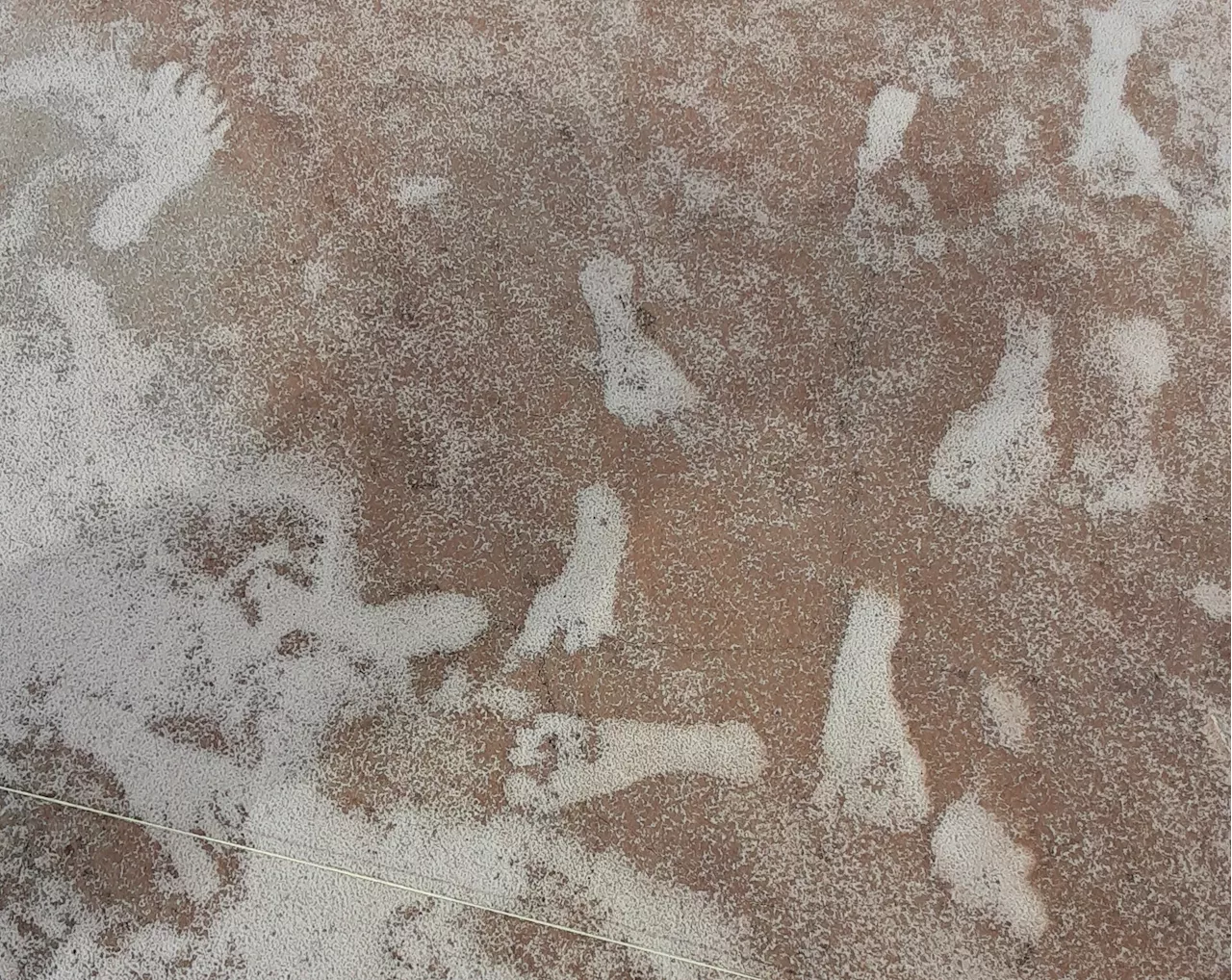New research shows that fossil footprints discovered at the edge of an ancient lakebed in New Mexico's White Sands National Park date back to between 21,000 and 23,000 years ago
This Oct. 2023, photo made available by the National Park Service shows human footprints infilled with white gypsum sand. at the White Sands National Park in New Mexico. Fossil human footprints discovered in White Sands, New Mexico likely date back to between 21,000 and 23,000 years ago, according to two lines of scientific evidence published on Oct. 5, 2023.
The new study presents two additional lines of evidence for the older date range. It uses two entirely different materials found at the site, ancient conifer pollen and quartz grains. Thomas Stafford, an independent archaeological geologist in Albuquerque, New Mexico, who was not involved in the study, said he “was a bit skeptical before” but now is convinced.
“Dating pollen is arduous and nail-biting,” said Kathleen Springer, a research geologist at the United States Geological Survey and a co-author of the new paper. Scientists believe radiocarbon dating of terrestrial plants is more accurate than dating aquatic plants, but there needs to be a large enough sample size to analyze, she said.
Brasil Últimas Notícias, Brasil Manchetes
Similar News:Você também pode ler notícias semelhantes a esta que coletamos de outras fontes de notícias.
 Further evidence points to footprints in New Mexico being the oldest sign of humans in AmericasNew research shows that fossil footprints discovered at the edge of an ancient lakebed in New Mexico's White Sands National Park date back to between 21,000 and 23,000 years ago
Further evidence points to footprints in New Mexico being the oldest sign of humans in AmericasNew research shows that fossil footprints discovered at the edge of an ancient lakebed in New Mexico's White Sands National Park date back to between 21,000 and 23,000 years ago
Consulte Mais informação »
 Further evidence points to footprints in New Mexico being the oldest sign of humans in AmericasNew research shows that fossil footprints discovered at the edge of an ancient lakebed in New Mexico's White Sands National Park date back to between 21,000 and 23,000 years ago.
Further evidence points to footprints in New Mexico being the oldest sign of humans in AmericasNew research shows that fossil footprints discovered at the edge of an ancient lakebed in New Mexico's White Sands National Park date back to between 21,000 and 23,000 years ago.
Consulte Mais informação »
 Further evidence points to footprints in New Mexico being the oldest sign of humans in AmericasNew research shows that fossil footprints discovered at the edge of an ancient lakebed in New Mexico's White Sands National Park date back to between 21,000 and 23,000 years ago. Previously, archaeologists thought human ancestors arrived about 15,000 years ago. The research was published Thursday in the journal Science. Scientists analyzed conifer pollen and quartz grains found at the site to reach date estimates. Earlier research that analyzed seeds of aquatic plants found at the site also produced similar date estimates. Ancient humans at White Sands lived alongside giant ground sloths, bison and other megafauna.
Further evidence points to footprints in New Mexico being the oldest sign of humans in AmericasNew research shows that fossil footprints discovered at the edge of an ancient lakebed in New Mexico's White Sands National Park date back to between 21,000 and 23,000 years ago. Previously, archaeologists thought human ancestors arrived about 15,000 years ago. The research was published Thursday in the journal Science. Scientists analyzed conifer pollen and quartz grains found at the site to reach date estimates. Earlier research that analyzed seeds of aquatic plants found at the site also produced similar date estimates. Ancient humans at White Sands lived alongside giant ground sloths, bison and other megafauna.
Consulte Mais informação »
 Further evidence points to footprints in New Mexico being the oldest sign of humans in AmericasNew research shows that fossil footprints discovered at the edge of an ancient lakebed in New Mexico's White Sands National Park date back to between 21,000 and 23,000 years ago.
Further evidence points to footprints in New Mexico being the oldest sign of humans in AmericasNew research shows that fossil footprints discovered at the edge of an ancient lakebed in New Mexico's White Sands National Park date back to between 21,000 and 23,000 years ago.
Consulte Mais informação »
 Further evidence points to footprints in New Mexico being the oldest sign of humans in AmericasThe evidence challenges the once-conventional wisdom that humans didn’t reach the Americas until a few thousand years before rising sea levels covered the Bering land bridge between Russia and Alaska.
Further evidence points to footprints in New Mexico being the oldest sign of humans in AmericasThe evidence challenges the once-conventional wisdom that humans didn’t reach the Americas until a few thousand years before rising sea levels covered the Bering land bridge between Russia and Alaska.
Consulte Mais informação »
 Further evidence points to footprints in New Mexico being the oldest sign of humans in AmericasNew research confirms that fossil human footprints in New Mexico are likely the oldest direct evidence of human presence in the Americas, a finding that upends what many archaeologists thought they knew about when our ancestors arrived in the New World.
Further evidence points to footprints in New Mexico being the oldest sign of humans in AmericasNew research confirms that fossil human footprints in New Mexico are likely the oldest direct evidence of human presence in the Americas, a finding that upends what many archaeologists thought they knew about when our ancestors arrived in the New World.
Consulte Mais informação »
